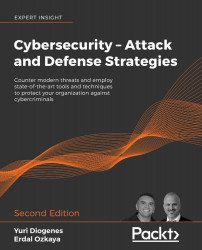Summary
The reconnaissance stage of a cyber attack is a key determinant of the overall attack process. At this stage, hackers are normally seeking to find a lot of information about their targets. This information is used in the later stages of the attack process. There are two types of reconnaissance: external and internal. External reconnaissance, also referred to as external footprinting, involves finding as much information as possible about a target while outside its network. The new tools used here include Webshag, Foca, PhoneInfoga, and Email Harvester.
Internal reconnaissance, also referred to as post-exploitation reconnaissance, involves finding more information about a target within their network. Some of the new tools used include Airgraph-ng, Hak5 Plunder Bug, CATT, and Canary token links. It is noteworthy that some of these tools have additional functionalities that go above doing basic scans. Internal reconnaissance tools will mostly yield richer information about...



